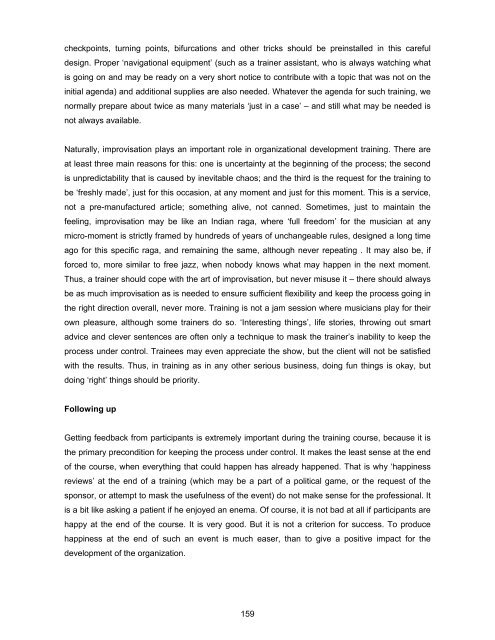Organizational Development: A Manual for Managers and ... - FPDL
Organizational Development: A Manual for Managers and ... - FPDL
Organizational Development: A Manual for Managers and ... - FPDL
You also want an ePaper? Increase the reach of your titles
YUMPU automatically turns print PDFs into web optimized ePapers that Google loves.
checkpoints, turning points, bifurcations <strong>and</strong> other tricks should be preinstalled in this careful<br />
design. Proper ‘navigational equipment’ (such as a trainer assistant, who is always watching what<br />
is going on <strong>and</strong> may be ready on a very short notice to contribute with a topic that was not on the<br />
initial agenda) <strong>and</strong> additional supplies are also needed. Whatever the agenda <strong>for</strong> such training, we<br />
normally prepare about twice as many materials ‘just in a case’ – <strong>and</strong> still what may be needed is<br />
not always available.<br />
Naturally, improvisation plays an important role in organizational development training. There are<br />
at least three main reasons <strong>for</strong> this: one is uncertainty at the beginning of the process; the second<br />
is unpredictability that is caused by inevitable chaos; <strong>and</strong> the third is the request <strong>for</strong> the training to<br />
be ‘freshly made’, just <strong>for</strong> this occasion, at any moment <strong>and</strong> just <strong>for</strong> this moment. This is a service,<br />
not a pre-manufactured article; something alive, not canned. Sometimes, just to maintain the<br />
feeling, improvisation may be like an Indian raga, where ‘full freedom’ <strong>for</strong> the musician at any<br />
micro-moment is strictly framed by hundreds of years of unchangeable rules, designed a long time<br />
ago <strong>for</strong> this specific raga, <strong>and</strong> remaining the same, although never repeating . It may also be, if<br />
<strong>for</strong>ced to, more similar to free jazz, when nobody knows what may happen in the next moment.<br />
Thus, a trainer should cope with the art of improvisation, but never misuse it – there should always<br />
be as much improvisation as is needed to ensure sufficient flexibility <strong>and</strong> keep the process going in<br />
the right direction overall, never more. Training is not a jam session where musicians play <strong>for</strong> their<br />
own pleasure, although some trainers do so. ‘Interesting things’, life stories, throwing out smart<br />
advice <strong>and</strong> clever sentences are often only a technique to mask the trainer’s inability to keep the<br />
process under control. Trainees may even appreciate the show, but the client will not be satisfied<br />
with the results. Thus, in training as in any other serious business, doing fun things is okay, but<br />
doing ‘right’ things should be priority.<br />
Following up<br />
Getting feedback from participants is extremely important during the training course, because it is<br />
the primary precondition <strong>for</strong> keeping the process under control. It makes the least sense at the end<br />
of the course, when everything that could happen has already happened. That is why ‘happiness<br />
reviews’ at the end of a training (which may be a part of a political game, or the request of the<br />
sponsor, or attempt to mask the usefulness of the event) do not make sense <strong>for</strong> the professional. It<br />
is a bit like asking a patient if he enjoyed an enema. Of course, it is not bad at all if participants are<br />
happy at the end of the course. It is very good. But it is not a criterion <strong>for</strong> success. To produce<br />
happiness at the end of such an event is much easer, than to give a positive impact <strong>for</strong> the<br />
development of the organization.<br />
159
















